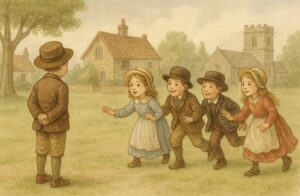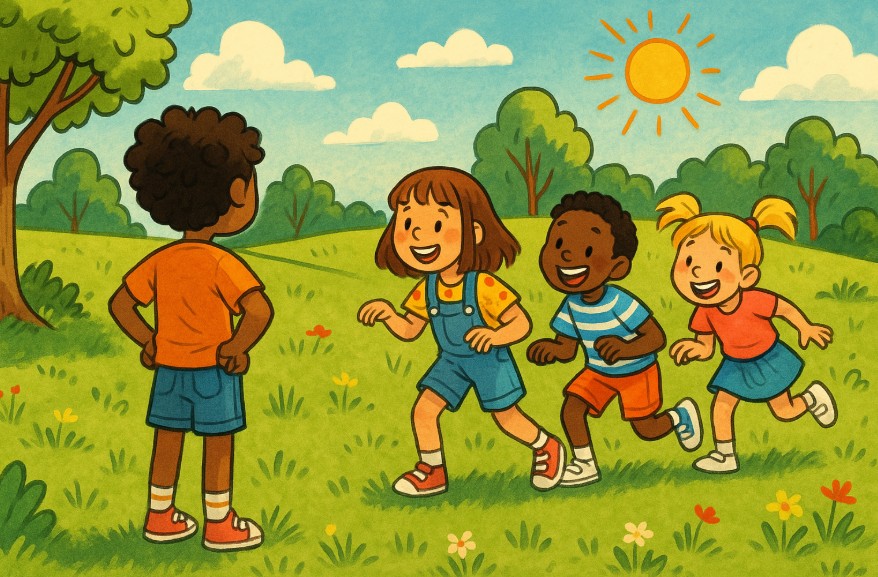“What’s the Time Mr Wolf?” is a traditional children’s game widely played across playgrounds, schools, and communities in the UK and other English-speaking regions.
Known for its simple setup, engaging rules, and educational benefits, it remains a staple of group play.
This guide explains how to play “What’s the Time Mr Wolf?”, including the rules, variations, benefits, and comparisons with similar games.
What Is “What’s the Time Mr Wolf?” and Where Did It Come From?

“What’s the Time Mr Wolf?” is a traditional outdoor game involving a group of players and one designated as “Mr. Wolf”. The concept of the game has existed for over a century, with early recorded versions in the United Kingdom and the United States.
In 1899, Percy B. Green documented the game in A History of Nursery Rhymes as “Pray, Mr. Fox, what time is it?”. Another early mention appeared in 1917 at the University of California, titled “If you please, Mr. Fox, what time is it?”.
Over time, the game evolved into various names and formats. Some regions changed the character from Mr. Fox to Mr. Wolf or Mr. Shark, and even adjusted the structure of the question.
Regardless of the changes, the core gameplay and player interaction have remained consistent, making it a widely recognised group activity in schools and playgrounds throughout the UK and beyond.
The game has gained popularity in countries such as Australia, Canada, New Zealand, Ireland, Hong Kong, and South Africa. It is celebrated for its simplicity, low resource requirements, and effectiveness in engaging children in physical and social play.
What Are the Basic Rules of What’s the Time Mr Wolf?
The rules of the game are simple, making it easy to introduce to groups of all ages. One player is chosen as “Mr. Wolf” and stands at one end of a defined space. The remaining players line up at the opposite end.
Gameplay proceeds with the group asking the wolf, “What’s the time, Mr. Wolf?” Mr. Wolf then responds with a time, such as “Four o’clock”. Players move forward that many steps while counting aloud. At any point, Mr. Wolf can respond with “Dinner time!” and turn to chase the players. If Mr. Wolf successfully tags someone, that player becomes the new wolf.
There are two primary responses that Mr. Wolf can give:
- A specific time, prompting players to move forward that many steps
- A meal time such as “Dinner time” or “Midnight”, which initiates a chase
This format creates anticipation and a blend of counting and reaction skills, offering both mental and physical engagement.
How Do You Play What’s the Time Mr Wolf Step by Step?
The game follows a straightforward structure that makes it ideal for classroom settings, playgrounds, or community events.
Step-by-step guide:
- Choose one player to be Mr. Wolf.
- Mr. Wolf stands with their back to the group at the far end of the play area.
- The remaining players line up on the opposite side.
- Players ask in unison: “What’s the time, Mr. Wolf?”
- Mr. Wolf replies with a time (e.g., “Three o’clock”).
- Players take that many steps forward, counting as they go.
- This is repeated until Mr. Wolf answers “Dinner time!” and chases the players.
- The first player to be tagged becomes the new Mr. Wolf for the next round.
Some versions of the game allow players to try sneaky or longer steps when Mr. Wolf’s back is turned. If caught or accused of cheating, they may return to the start or become Mr. Wolf by default.
What Skills Does This Game Help Develop in Children?

“What’s the Time Mr Wolf?” is more than just an entertaining playground game. It plays a vital role in childhood development by integrating cognitive, physical, and social learning experiences.
By participating in this activity, children practise a range of important skills that support both their academic growth and personal development.
Physical Development
One of the most evident benefits of the game is physical exercise. Children are required to run, walk, and stop suddenly, improving their gross motor skills and overall coordination. Regular physical activity like this enhances cardiovascular endurance, muscle strength, and balance.
- Encourages dynamic movement such as sprinting, stepping, and sudden stopping
- Develops coordination between movement and verbal cues
- Builds stamina and muscle control through repeated activity
These physical benefits are particularly valuable in early childhood when motor skills are still being refined.
Cognitive Skills
“What’s the Time Mr Wolf?” supports cognitive development by requiring children to listen attentively, process instructions, and act accordingly. When Mr. Wolf calls out a time, players must convert that auditory information into physical movement—taking the correct number of steps. This supports auditory processing, working memory, and numeracy.
- Enhances number recognition and counting ability as children step according to the time
- Strengthens listening skills by focusing on spoken instructions and cues
- Improves decision-making and self-control, especially when resisting the urge to run early
Children must also think ahead and assess when Mr. Wolf is most likely to call “Dinner time!”, which adds a layer of strategic reasoning and anticipation.
Executive Function
According to research from institutions such as Harvard University’s Center on the Developing Child, games that involve rules, sequences, and memory recall are crucial for developing executive function in children. This includes:
- Inhibitory control – The ability to stop oneself from moving when inappropriate
- Cognitive flexibility – Adapting to sudden changes in gameplay, such as a chase beginning unexpectedly
- Working memory – Remembering instructions and step counts in real-time
These skills are foundational for success in school environments, particularly in tasks that require attention, following directions, and managing impulses.
Social and Emotional Learning
Group games like this foster social interaction, turn-taking, and collaboration. Since players must follow collective instructions and respect the rules, they develop an understanding of fair play and empathy. Playing the role of Mr. Wolf also helps build confidence, as it requires leadership, decision-making, and vocal participation.
- Encourages group participation and teamwork
- Teaches fairness, rule-following, and respecting others’ turns
- Builds self-esteem, especially when a shy child volunteers to be Mr. Wolf
- Helps children manage emotional responses, such as the excitement or disappointment of being tagged
These elements contribute to a child’s ability to form healthy relationships and communicate effectively with peers.
What Are the Variations of What’s the Time Mr Wolf Around the World?
The core mechanics of the game remain unchanged, but many local variations exist depending on cultural influences and environment. Each variation retains the question-and-response interaction but adds unique twists.
Regional Variants Table
| Country/Region | Variation Name | Key Differences |
| United Kingdom | Mr. Wolf with sneaky steps | Players may take extra steps undetected |
| United States | Captain Midnight | Similar game with different phrasing |
| Australia | What’s the Time Mr Wolf? | Played similarly to UK version |
| Canada | What’s the Time Mr Wolf? | Standard structure, common in schools |
| Hong Kong | 狐狸先生幾多點 | Played in Cantonese, uses “十二點” as end signal |
| North America | What’s the Time Mr Shark? | Played in water-based settings like pools |
| Italy | Lupo Delle Ore | Similar rules, different character name |
Some variations involve props such as dandelions. In this version, Mr. Wolf holds a dandelion seed head and calls out times after each blow. When the last seed is gone, Mr. Wolf declares “Dinner time!” and chases the players.
Others introduce a wall or fixed point behind Mr. Wolf. Players try to reach this spot undetected and declare “Safe” to avoid being caught. If Mr. Wolf hears extra steps, they may turn and accuse the player, resulting in penalties or role reversal.
How Can You Make What’s the Time Mr Wolf More Fun or Challenging?

While the traditional format of “What’s the Time Mr Wolf?” is simple and enjoyable, there are many ways to enhance the game to maintain engagement, increase difficulty, or tailor it for specific age groups and settings.
Adding variations not only keeps the game fresh but also introduces new skills, strategies, and dynamics that appeal to a broader range of children.
Introducing Role-Playing and Themed Characters
Instead of always using Mr. Wolf, the game can be adapted with themed characters depending on the environment or occasion. For example:
- Mr. Shark for water-based play at the beach or in a paddling pool
- Mr. Dragon for fantasy-themed parties or classroom storytelling activities
- Mr. Robot for a science and technology theme
This minor change can completely refresh the game, spark imagination, and make it more immersive for children, especially during themed events or educational activities.
Adding Sneaky Steps and Stealth Elements
A commonly enjoyed variant in the UK involves adding an element of stealth. Players are allowed to take slightly longer or additional steps when Mr. Wolf’s back is turned. However, they risk being caught or accused of cheating if the wolf hears or sees them.
To implement this:
- Mr. Wolf can call out “Heard you!” and turn to identify the player who moved unfairly.
- If the guess is correct, the player returns to the starting line or becomes the new Mr. Wolf.
- If incorrect, gameplay resumes normally, adding suspense and excitement.
This variation promotes discretion, careful planning, and risk assessment, as players must decide whether the reward of moving closer outweighs the risk of being caught.
Creating a Safe Zone or Home Base
Another engaging addition is to introduce a “home” or “safe zone” located behind or beside Mr. Wolf. Players who manage to reach the home base without being tagged can declare themselves “Safe!” and are exempt from being caught during that round.
This changes the game’s dynamic by shifting the players’ goal from simply avoiding Mr. Wolf to actively trying to outsmart and bypass him. It also adds an end-goal to the chase, giving players a sense of achievement.
Possible home base rules:
- The first few players to reach home are safe for the rest of the game
- Once a player reaches home, they must cheer for or distract Mr. Wolf (without interfering)
- Players who reach home cannot rejoin until the next round, encouraging rotation
Playing in Teams or With Multiple Wolves
For larger groups, dividing players into teams or introducing multiple wolves can add complexity and structure to the game. In this format:
- Teams can take turns stepping forward based on the called time
- Multiple wolves can tag players from different directions
- One wolf gives the time while the others stay hidden and begin chasing on signal
This version promotes collaboration, teamwork, and strategic thinking, especially when players must decide the safest direction to move or whether to follow others.
Using Props and Physical Markers
Adding physical items or marked zones to the play area makes the game more interactive and visually structured. Ideas include:
- Chalk lines or cones to define the number of steps
- Ropes or tape to set clear boundaries for the play area
- Dandelions or flags that Mr. Wolf interacts with before calling “Dinner time!”
Props make the game suitable for both indoor and outdoor environments and help younger children visually understand game boundaries and progress.
Playing on a Hopscotch Grid
In this version, players use a pre-drawn hopscotch court and advance by hopping instead of walking. When Mr. Wolf calls “Dinner time!”, players must hop back to the start while avoiding being tagged. This adds an extra layer of difficulty through balance, coordination, and controlled movement.
It’s especially useful in physical education settings where combining traditional games with motor-skill activities is beneficial.
Adjusting Difficulty for Different Ages
To cater to mixed-age groups or different ability levels, the game’s rules can be slightly adjusted:
- Younger children: Shorter steps, slower chases, more frequent resets
- Older children: Larger play area, complex chase paths, timed rounds
- Inclusive play: Assign helper roles to children who might not run as fast, such as being the timekeeper or the assistant wolf
These adjustments ensure that all children can participate meaningfully and enjoyably.
Introducing a Countdown or Timer
To build urgency and pacing into the game, you can introduce a countdown clock. For example, players must reach Mr. Wolf within five minutes, or they lose the round. This motivates quicker thinking and movement, particularly beneficial in structured environments such as schools or camps.
| Enhancement Type | Description | Skills Promoted |
| Themed characters | Adapts the wolf into sharks, robots, dragons, etc. | Imagination, creativity |
| Sneaky steps rule | Allows risk-taking with penalties | Decision-making, stealth, observation |
| Safe zones or home base | Adds a goal and safe point for players | Strategy, speed, spatial planning |
| Multiple wolves or teams | Introduces collaboration and complexity | Teamwork, competition, anticipation |
| Use of props | Adds physical structure and interactivity | Motor skills, object interaction |
| Hopscotch version | Requires hopping instead of walking | Balance, coordination |
| Timed rounds | Introduces pacing and urgency | Time management, reaction speed |
These optional features make “What’s the Time Mr Wolf?” a game that can be continually adapted, offering endless entertainment while reinforcing key developmental skills.
What’s the Equipment or Space Required to Play?

The game is notably accessible because it requires minimal preparation. A suitable playing area and a group of participants are the only essentials. However, adaptations may require additional elements depending on the chosen variant.
Equipment and Setup Table:
| Requirement | Description |
| Number of players | Minimum 2, recommended 5–10 for optimal gameplay |
| Playing area | Open space such as playground, park, or large indoor hall |
| Props (optional) | Wall, cones, chalk lines, dandelion, or hopscotch grid |
| Setup time | Less than one minute |
| Supervision | Advised for younger children to ensure safe play |
| Game duration | Flexible, typically 5–10 minutes per round |
This minimalistic requirement makes it ideal for schools, community centres, or even home back gardens.
How Does What’s the Time Mr Wolf Compare to Other Traditional Games?
“What’s the Time Mr Wolf?” shares characteristics with various childhood games around the world, but it also stands apart due to its combination of suspense, counting, and chase elements. The table below provides a comparison.
Comparative Table
| Game Name | Common Traits | Distinct Feature |
| Red Light, Green Light | Involves movement control | Commands are colour-based, not time-based |
| Duck Duck Goose | Uses tag-and-chase format | Played in a circle, less structured movement |
| Tag | Chase-oriented game | Lacks anticipation built through timed responses |
| Captain Midnight | Starts with “Midnight” as a cue | Skips counting and clock-telling components |
This comparison highlights the unique value of “What’s the Time Mr Wolf?” as both a learning tool and a playful activity.
Conclusion
“What’s the Time Mr Wolf?” remains a time-tested favourite among traditional children’s games. Its ease of play, flexible variations, and educational value make it an excellent choice for schools, parties, and community gatherings.
Whether using the classic format or adapting it with regional or imaginative twists, the game provides children with the opportunity to engage physically, think strategically, and collaborate in fun ways.
Frequently Asked Questions
Is What’s the Time Mr Wolf suitable for all ages?
Yes, the game is adaptable for children of all ages and even adults. Rules can be adjusted based on age group to make it engaging for everyone.
Can you play What’s the Time Mr Wolf indoors?
Yes, provided there is enough space to run safely. School halls and gymnasiums are suitable locations.
What do you need to prepare before playing the game?
No equipment is required, but an open space and clear safety rules should be set. Optional props like cones or walls can enhance gameplay.
How long does one round of What’s the Time Mr Wolf take?
A round typically lasts 5–10 minutes, depending on the number of players and how quickly someone is tagged.
How does this game help with a child’s development?
It improves physical coordination, time awareness, memory, and social interaction, making it ideal for both recreational and educational environments.
Are there team versions of What’s the Time Mr Wolf?
Yes, in some variants multiple wolves can work together to tag players, especially in larger groups.
Can adults join in What’s the Time Mr Wolf?
Absolutely. It’s a fun activity at family gatherings, picnics, or school events where adults want to engage with children.







